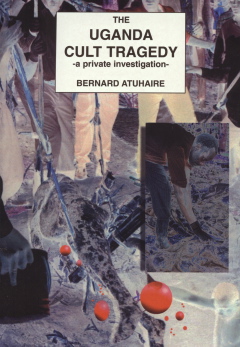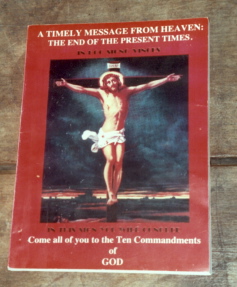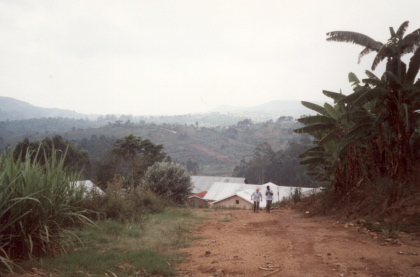
Until March 2000, nearly nobody outside of Uganda had ever heard of the Movement for the Restoration of the Ten Commandments of God, a local breakaway group from the Roman Catholic Church. The MRTCG had emerged around visionaries who shared their messages and were able to attract a following which even included a few priests. There has been a significant subculture of visionaries in Uganda, a context into which one should place the MRTCG.
When the events of March 2000 took place, no scholar outside of Uganda knew anything about the MRTCG. Only a few educated Ugandan priests were reasonably well-informed, but nobody had foreseen what would happen. Few international media have correspondents in Uganda: the BBC’s Anna Borzello did a fine job in reporting on the event. Some newspapers or TV channels sent teams on short trips to Uganda in order to cover the case.
However, in comparison with the scholarly attention that such an event would have attracted if it had happened in North America or Europe, little research was undertaken by the international community of scholars dealing with contemporary religious movements. Except for one small volume published by a team of Ugandan scholars shortly after the events, no full-length book has been published to before Azuhaire’s contribution.
For this reason, any contribution toward our understanding of the MRTCG is welcome. This is why Bernard Atuhaire’s book deserves attention.
Born in South-Western Uganda, Atuhaire received an academic training in linguistics and teaches English in Spain. He would never have been interested in the MRTCG if several relatives had not become members. This led him to pay several visits to the place, and to fly to Uganda – which he visits regularly – shortly after the events.
His book does not claim to offer a sociological treatment of the case and does not claim to be dispassionate: Atuhaire’s goal is to share with us the knowledge he has gathered over the years, both before and after the event, and also his concern about what happened and might take place again in other groups. Some remarks may also reflect reminiscences of the “cult controversies” in the Northern hemisphere, since those tend often to inform comments made on fringe movements around the world. However, one would do well to remember that the reality of some groups sometimes does indeed match cult stereotypes.
This 140 page volume represents the kind of material that scholars will be quoting in future research pieces. Atuhaire himself is aware that “much is unknown today [about the Movement] and much might remain unknown for ever” (p. 1).
Atuhaire first summarizes the context in which the MRTCG developed, as well as its prominent members and key beliefs, quoting extensively from the key book of the movement, A Timely Message from Heaven. He is also critical of what he considers as neglect by authorities: according to him, a security officer had warned that the MRTCG was a “security menace”, but had not been listened to.
According to his observations, the MRTCG was not just a place of shelter for deprived people: while there were many people of simple background, there were other ones higher on the social ladder. “The only promised reward was the passage to a new generation and the gift of heaven” (p. 29). Members also believed that belonging to the movement would save them from calamities such as AIDS – quite prevalent in Uganda at the time the MRTCG developed, and seen by it as a consequence of the lack of respect for the Ten Commandments.
People living inside the MRTCG led a communal life: they were called on to sell what they owned, give the proceedings to the movement and “follow Jesus” (p. 33). Material wealth did not matter: only spiritual goods were deemed to be important.
Atuhaire offers some insights into the life of members residing at one of the MRTCG’s centres. Residents tended to be closed off from the outside world, although not in a physical sense: there were no walls or entrance gates. One of the factors that isolated them was the rule of silence:
“Entrance to the quarters of The Movement meant entrance to a silent world. Speech was highly discouraged except in prayer, when settling members’ problems or when receiving visitors. […] In this manner, the free expression of the members was done away with. […] Speech was replaced by the use of sign language […]” (p. 49).
There was obviously a high level of control on communications, and those communications that took place were highly controlled.
There were two sessions of prayer daily, one from 3 a.m. until 8 a.m., the other from 6 p.m. until 10 p.m.

Members were aware of the reports from different places of alleged apparitions of the Virgin Mary around the world. While it was an independent and specific movement, it can obviously be fully understood only if put within this wider context of Marian visionary networks.
While the MRTCG was outside the pale of the Roman Catholic Church, its practices were largely inspired by Roman Catholicism, with its practice of the various sacraments, thanks to the presence of priests within the group.
This also meant that the Roman Catholic Church was first among the group’s opponents. Then came family members, since the group tended to become a substitute family; moreover, the fact that members sold their land in order to join upset their relatives, considering the importance of land in Ugandan society: “Land means everything in terms of employment, family and social stability and the inter-relationship between them” (p. 69). This even led to local court cases in order to retain land ownership and prevent the dire consequences of losing it. However, Atuhaire feels that families opposed to the group did not receive the attention they deserved.
The third group were deserters, i.e. people who had left the group. According to Atuhaire’s observations, deserters from the movement were sometimes harassed (p. 31), and there were attempts to bring them back – a not unsignificant observation, in the light of claims that growing dissent inside the MRTCG might have played a role in the 2000 explosion. It seems that some members had difficulties with the harsh life within the group. Some reported mistreatment of minors; others resented the “privileged treatment” enjoyed by some members. For instance, Atuhaire reports, “girls from the privileged core lived in seclusion and were exempt” from work such as drawing water and kitchen work (p. 61).
Most of the deserters were simple people, and what they said did not get much attention – although, Atuhaire suggests, they would have been the most qualified ones to tell more about what was taking place. A few leaders of the group left too, however, such as a priest, Fr. Paul Ikazire, in 1994.
Atuhaire thinks that the fact that opposition was fragmented prevented it from gaining much attention or being really effective. Moreover, the stiff family opposition that was observed at the beginnings of the movement “became increasingly less resolute” (p. 75).
Atuhaire devotes some space to the issue of date-setting in the MRTCG regarding the end of times, the end of this world and the establishment of a new one after great chastisement. Atuhaire observes that changing dates were evoked within the group and is of the opinion that the last one was 31st December 1999, while some other researchers who have studied the group are of the opinion that the end of December 1999 did not play a great role within the movement, which instead believed that the current world would come to its end before the close of the year 2000.
Whatever dates were predicted, it is reasonable to think that, since members had been told they would spend the three days of darkness preceding the advent of the new world in shelters, they gathered in the building at their headquarters in Kanungu with this belief, not knowing it would be set on fire after the door and windows had been nailed shut ….

“On the scene of the inferno, it could be appreciated that members of the Movement had burnt their earthly belongings ahead of that fateful morning” (p. 84). Other evidence was gathered by the undersigned while researching the group and talking to witnesses, such as the sale of properties and goods owned by the group at well below market prices, while debts were settled (including taxes). There is no doubt that what happened had been well-planned and foreseen. The corpses found in mass graves leave no room for the possibility of an accidental fire.
But why were bodies later found in mass graves at four different locations? Those people were in part killed weeks before the fire on 17 March 2000. Atuhaire is aware that there is much uncertainty remaining, but inclines to think that those earlier killings were related to a need to suppress dissent and discontent within the movement.
Beside the murders (and possibly suicides of the leaders) as a way of escaping from growing discontent and possible mass desertion, Atuhaire draws our attention to the fact that the leader of the group, Joseph Kibwetere, had to be treated in 1998 at a mental hospital for manic depression, “a sickness that causes a person to lose contact with reality” (p. 87). It is not completely surprising that such a leader could come to fateful decisions. In addition, there may have been some threat of impending pressure from the government, due to reports of malpractice within the movement that might have reached the capital, Kampala.
There may also have been dissensions within the leadership itself: it cannot be ruled out that some of the hacked or strangled bodies found in graves were those of leaders or apostles within the MRTCG, following divisions and arguments within the leadership: “The strong swallowed the weak and an explosive situation was around the corner” (p. 96).
In all events, a great deal of mystery remains about what really happened, Atuhaire acknowledges, and we will probably never know the full truth. We should also remember that the corpses were mostly burnt beyond identification, which means nobody knows for sure if and where the different leaders died, although it seems likely that they lost their lives too.
The appendixes offers a selection of some interesting documents, several of them translated from local languages, including a confession written by a member, in the form of a letter from Credonia Mwerinde (a leading seer within the MRTCG) to the author.
This is not the only case of a close-knit group committing mass murders or mass suicides in recent decades: but the Ugandan case might be – in terms of numbers – the largest one (according to Atuhaire’s figures) or the second largest (after the Peoples Temple in Jonestown, Guyana). Definitely, the case of the MRTCG deserves investigation, and material such as Atuhaire’s book is welcome. Five years have already elapsed since the March 2000 events, while little research has been done, and much knowledge that we might have reaped from the case is likely to disappear with the passing years.
Jean-François Mayer
Bernard Atuhaire, The Uganda Cult Tragedy: A Private Investigation, London: Janus Publishing Company, 2003, XXX+138 pp.
Website of the publishing house: www.januspublishing.co.uk
In addition, a short research report by Jean-Francois Mayer was published following two investigative trips to Uganda: “Field Notes: The Movement for the Restoration of the Ten Commandments of God”, Nova Religio: The Journal of Alternative and Emergent Religions, Vol. 5, No. 1, Oct. 2001, pp. 203-10.